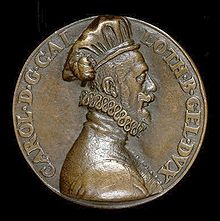- Charles II, Duke of Lorraine
-
Charles II (1364 – January 25, 1431), called the Bold (French: le Hardi) was the duke of Lorraine from 1390 to his death and constable of France from 1418 to 1425.[clarification needed] Charles was the elder son of John I, Duke of Lorraine, and Sophie, daughter of Eberhard II, Count of Württemberg.
He is called Charles II because of a previous Charles, Duke of Lower Lorraine, despite the fact that his own duchy was that of Upper Lorraine; Lower Lorraine being subsumed in Brabant by his time.
During his youth, he had been close to Philip II, Duke of Burgundy, they having been comrades in arms on several occasions. This proximity to Burgundy was largely a result of his father's moving away from the French court, the court to which the Lorrainer dukes had neared in the past century and a half as they withdrew from the Holy Roman Empire, within which their duchy was still technically a vassal state. Charles was defiant of Louis I, Duke of Orléans, who had supported the citizens of Neufchâteau against his father and the Emperor Wenceslaus when the latter was accused by his subjects of weakness. Wenceslaus was deposed in 1400 and replaced by Rupert III, Count Palatine of the Rhine, Charles' father-in-law.
Charles was also a major participant in some late Crusading movements. He was at Tunis in 1391. He took part in the so-called Last Crusade which culminated in the disastrous Battle of Nicopolis in 1396. There he accompanied John the Fearless, the count of Nevers and son of his friend Philip. In 1399, he assisted the Teutonic Knights in Livonia.
Multiple times between 1405 and 1406, the sergeants of the duke and the officers of the kings of France in certain enclaves (French fiefs) in Lorraine were at loggerheads and Louis of Orléans, who had received the pledges of the duke of Luxembourg, was trying to create a principality in the region. Then, in 1407, at the head of a coalition of the dukes of Bar, Luxembourg, and the margraves of Namur he attacked the duchy. Louis was defeated at Corny-sur-Moselle and then, in July, at Champigneulles. His assassination in Paris on 23 November put an end to his plans.
With the assassination of Louis, France broke down into two parties: the Armagnacs of Bernard VII, Count of Armagnac, the tutor of the young Charles of Orléans, and the Burgundians of John the Fearless, Philip's successor, who supported Charles of Lorraine. Charles did not, however, enter the Anglo-French conflict then raging—the Hundred Years' War—but his brother, Frederick I, Count of Vaudémont, got involved and died in the Battle of Agincourt in 1415. Nevertheless, the queen, Isabeau of Bavaria, appointed Charles constable in 1418. In 1424, he asserted that the load was too large for him and renounced it.
Charles adopted a new stance vis-à-vis France after the assassination of John of Burgundy in 1419. John's successor, Philip III, had much territory in the Low Countries and only Lorraine and Champagne separated his Burgundian from his Belgian possessions. Fearing any warlike ambitions, Charles thought it prudent to reorient his fidelities and friendships away from such a possible adversary. Through his French connections, he obtained the assistance of Charles VII against Burgundy and married his daughter to the Angevin René, later king of Naples.
Charles's final years were rife with conflict and unhappiness. His nephew, Anthony of Vaudémont demanded a part of the inheritance and Charles had to war against him in 1425, without much success. Early in 1429, Joan of Arc came on a pilgrimage to Saint-Nicolas-de-Port. She counselled the duke to abandon his mistress, Alison du May. Ignoring this advice, he gave her an escort and sent her on to Chinon. He died two years later at his capital of Nancy on 21 or 25 January.
Family
From his marriage to Margaret of the Palatinate (1376–1434), daughter of Rupert of Germany and Elisabeth of Nuremberg, in 1394, only two daughters survived childhood:
- Isabella (1400–1453), who became Duchess on his death and married René, later holder of many prestigious titles
- Louis, died young
- Ralph, died young
- Catherine (1407–1439), married Jacob, Margrave of Baden
With his mistress, the aforementioned Alison du May (murdered in Nancy in 1431), he had five children:
- John, lord of Darnieulles
- Ferry de Lunéville (fl. c. 1425)
- Catherine (fl. c. 1425)
- Isabelle, married in 1425 to Henry of Liocourt
See also
Preceded by
John IDuke of Lorraine
1390–1431Succeeded by
Isabella of Lorraine &
René of AnjouCategories:- Dukes of Lorraine
- Constables of France
- 1364 births
- 1431 deaths
Wikimedia Foundation. 2010.

